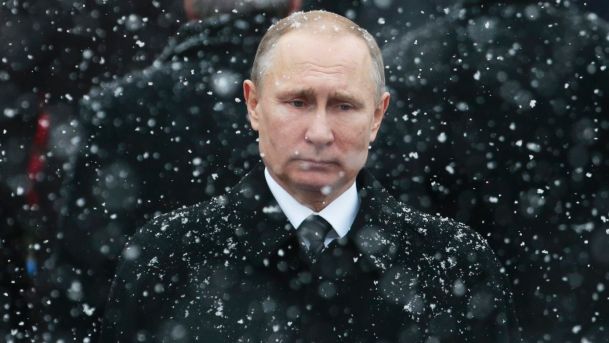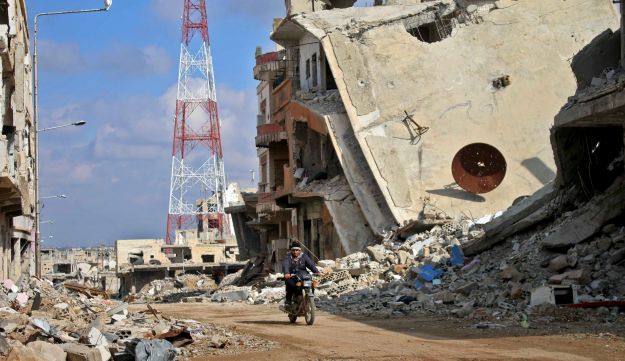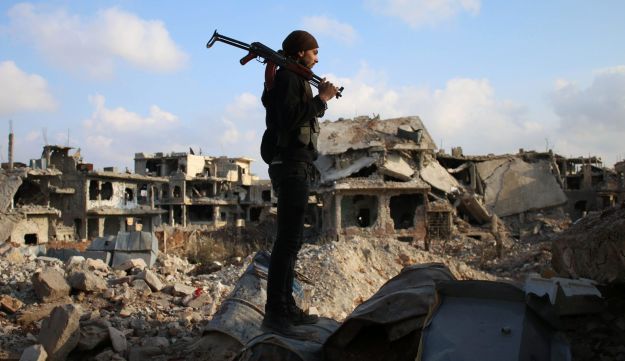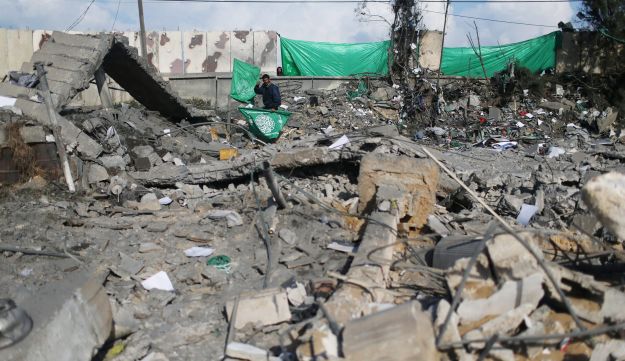
Six years after the start of the Syrian civil war, an Assad victory now seems assured thanks to Russia’s military intervention. But Israel’s biggest concern is Iran’s increasing influence in the region.
Snow falls as Putin attends a wreath-laying ceremony marking the Defenders of the Fatherland Day at the Tomb of the Unknown Soldier in Moscow, Russia, Feb 2017 Ivan Sekretarev/AP
Israeli Air Force strikes targets in Syria; Assad forces threaten ‘direct’ retaliation
Opinion The citizens of Israel are hostages of Iran and Hezbollah
Syria’s Assad will remain in power as a pariah, experts say
The sixth anniversary of the outbreak of the Syrian civil war was marked this week by a series of massacres and bombings from both sides, culminating in a series of coordinated suicide attacks in the capital, Damascus. (This article was written prior to events overnight Thursday between Syria and Israel.) However, the dozens of fatalities in the heart of an area controlled by the Syrian regime does not alter what has already been determined: That this past year was the one in which dictator Bashar Assad snatched victory from the jaws of defeat.
The Russian intervention, which began in September 2015 with several dozen warplanes being sent to Syria, turned the war right around. In late 2016, the regime chalked up its biggest achievement – the surrender of rebel groups in Aleppo. And even though fighting continues around the country, it now seems that President Assad’s rule is in no danger of collapsing.
Syria has become a big stage, the field on which world powers, neighboring countries, ethnic groups and tribes all slug it out, while hundreds of thousands of Syrian civilians are slaughtered and millions more become exiles in their own country or refugees beyond its borders.
The fallout from the war has spread far beyond Syria. The wave of refugees from the Middle East, along with several deadly terror attacks, changed the internal political situation in Europe, and indirectly influenced the atmosphere that led to the surprising result in the U.S. presidential election.
The success of the Shi’ite Muslim axis – which led Iran to support Assad’s regime – was ultimately based on the murderous air power deployed by the Russians. Both Tehran and Moscow benefitted from this. Russia reemerged on the world scene and reimposed a dual-superpower international reality. And in contrast to complaints leveled by Arab states against the United States during the Obama era, Russia has demonstrated that it does not abandon its wards. It positioned itself as the leader of the diplomatic process aimed at bringing about a cease-fire in Syria, and created new landscapes that are affecting the principal arena of its tussles with Washington, Eastern Europe – and also used Syria as a testing ground for its latest weapons systems.
This week, it was reported that Russian commando teams have been sent to Western Egypt, in order to help the Libyan National Army led by Marshal Khalifa Haftar, who is fighting for control of Libya. The denials by all concerned are not convincing. Moscow is stretching a long military arm into places that could serve its interests – and Libya’s huge oil reserves are without doubt of interest to it.

A Syrian man riding his motorcycle past damaged buildings in the southern city of Daraa, March 16, 2017.MOHAMAD ABAZEED/AFP
Iran is also expected to benefit from the prolonged attack the United States is leading to capture Mosul from the Islamic State group. Expelling the jihadist fighters from the northern Iraqi city will make it possible to create a contiguous swath of Iranian-Shi’ite influence on the ground from Tehran, through Mosul to Damascus, and on to Bekaa and Beirut in Lebanon.
The moves that were reported in the past two weeks – the attempt to establish an Iranian port in the area of Tartus and Latakia in Syria, and the construction of plants to manufacture rockets for Hezbollah in Lebanon – seemingly fit the big plan: not only a contiguous swath on the ground, but also entrenchment of the arc of Shi’ite influence – stretching from the eastern shore of the Mediterranean Sea in the north to Yemen in the south.
Aggressively spurred on by Prime Minister Benjamin Netanyahu, the Israeli intelligence community has for many years warned of the Iranian nuclear threat. Now it has moved on to talking about “Iran in the region” as the main focus of concern. And Israel is the one talking about these dangers.
Netanyahu revealed the plan for the Iranian port during his visit to Russian President Vladimir Putin last week. The Iranians are in talks with Assad about leasing land for 50 years – an arrangement similar to the one in which the Russians obtained their port in the city of Tartus. And news of the Iranian munitions factories in Lebanon, which were recently transferred to Hezbollah, was published in a Kuwaiti newspaper.
Both these moves are disturbing. An Iranian presence on the shores of the Mediterranean is also alarming to the European Union. Relocating the rocket production lines to Lebanon will reduce Hezbollah’s dependence on the smuggling convoys that frequently encounter mysterious airstrikes on Syrian roads.

A rebel fighter standing amid the rubble of destroyed buildings in the rebel-held area of Daraa, in southern Syria, March 14, 2017.MOHAMAD ABAZEED/AFP
What Israel needs to do in response is to develop a coherent policy with clear priorities, in order to halt Iran’s next moves.
Netanyahu set himself the very ambitious goal of eliminating the Iranian nuclear program. He opposed the Vienna plan (agreed between Iran and six world powers), and therefore could not allow himself to brag that the agreement could stall the Iranian nuclear threat for nearly a decade. But in reality, Israel’s threats to launch a military attack on Iranian nuclear sites, along with the identification of possible channels for sanctions against the regime in Tehran, contributed to the U.S. and international effort to impose the sanctions – hence helping force the Iranians to accept the compromise agreement in Vienna.
Now, Netanyahu has to maneuver in an equally complex field – between Russia’s increasing involvement in the region and the administration of U.S. President Donald Trump, which is still finding its feet.
Meanwhile, back in Gaza…
Another rocket launched from the Gaza Strip hit an unpopulated area in the northern Negev on Wednesday evening. This has happened at least once a week over the last month, but Israel is maintaining its line that those responsible for the rocket fire are extremist Salafi organizations, while hitting Hamas security positions in retaliation. The airstrikes – Israel Air Force jets attacked two Hamas targets in the northern part of the Gaza Strip on Wednesday night – were aimed at underlining the Israeli demand that Hamas maintain quiet and rein in the rogue organizations.

A Hamas site in Dir al-Balah that Gazan police say was hit by an Israeli airstrike, March 16, 2017. IBRAHEEM ABU MUSTAFA/REUTERS
In recent weeks, Hamas’ leaders in the Gaza Strip have warned that they will not stand for any more Israeli attacks as punishment for Salafi actions. This week, a senior Hamas official, Fathi Hammad, stated that if the siege on the Gaza Strip is not lifted, “an explosion is coming.” It seems as though the state comptroller’s report into the 2014 Gaza war, which was published at the end of last month, is being rewritten anew these days. Though the Israeli security cabinet is currently busier than ever with possible alternatives for dealing with Gaza, some of its members get the feeling that a lot of things are being discussed privately, in little tête-à-têtes between Netanyahu and Defense Minister Avigdor Lieberman.
There have been lots of public spats between governing coalition ministers this week: Finance Minister Moshe Kahlon versus PM Netanyahu; Lieberman versus Education Minister Naftali Bennett. In coming months, these skirmishes may give way to a bigger clash – between Israel and Hamas.
Amos Harel
Haaretz Correspondent
www.haaretz.com



